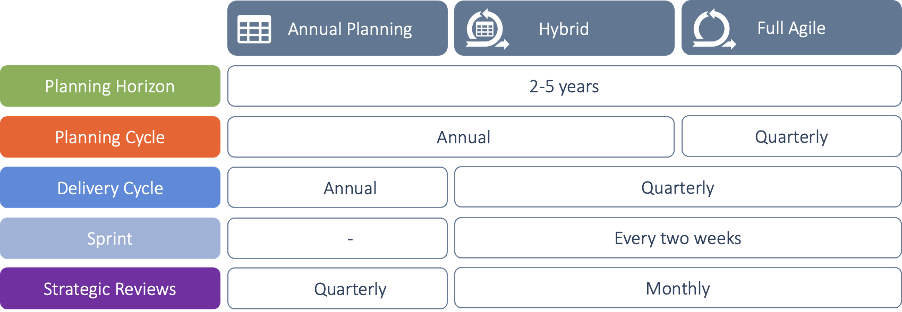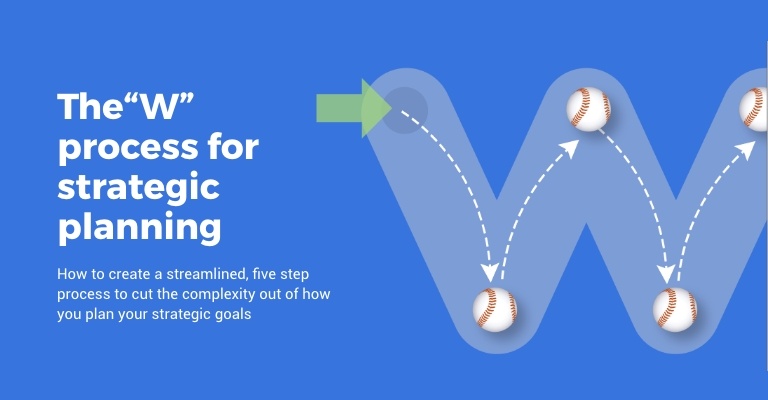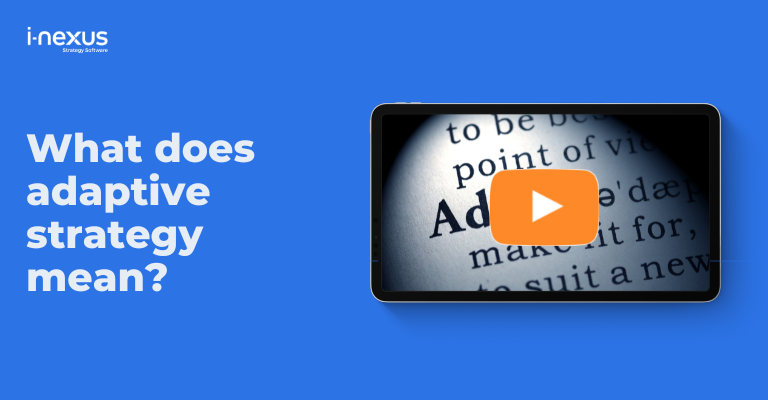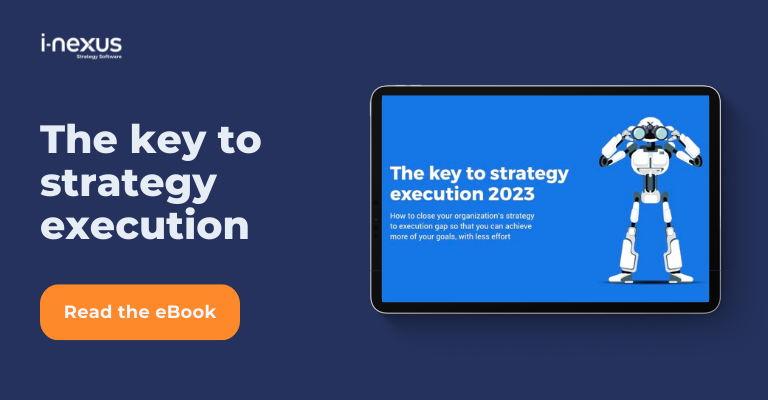While classical strategic planning models are effective in traditional markets and environments, we no longer live in this world. To thrive here requires planners to evolve and adapt their practices. Find out why one strategic planning model - hybrid - stands head and shoulders above the rest.
Agile has pushed beyond its roots in software development and into other functions in the business. With it comes a fresh workstream or project management approach, the promise of “continuous” delivery, and greater responsiveness to change.
But can agile principles also be applied to strategy and strategic planning?
In this age of uncertainty and volatility, strategic planning surely would benefit from increased responsiveness.
This blog explores eight strategic planning models to find those that will support your organization to be continuous - and adaptive - when it comes to a continuous approach to strategy.
Classic types of strategic planning
Three classical strategic planning models are rational, incremental, and organic.
1. The rational model of strategic planning
The rational model is a top-down, step-by-step process in which a company analyzes its industry, competitors, and environment to identify opportunities and threats.
It then develops strategies to take advantage of the opportunities and address the threats.
The benefits of a rational model
This rational model is beneficial because it allows for a systematic and analytical approach to decision-making in your organization.
It also helps to ensure that all possible outcomes are considered and that the best course of action is chosen based on available information.
Additionally, a rational model encourages planners to think ahead and anticipate potential problems or challenges.
The challenges of a rational model
However, the rational theoretical framework assumes that managers are fully informed, able to calculate the best course of action, and motivated to act in the best interests of their firm.
While this may be a reasonable assumption in some cases, it does not reflect the reality of many business environments.
Managerial decision-making is often influenced by biases, emotions, and personal agendas, which can lead to suboptimal outcomes.
In addition, complex systems cannot be accurately modeled using rational analysis alone, so managers must rely on their intuition and experience to make decisions in uncertain situations.
2. The incremental model of strategic planning
The incremental model is also a top-down process but is more flexible than the rational model.
The company begins by identifying its goals and objectives and developing strategies to achieve them.
The benefits of an incremental model
An incremental strategic planning model is beneficial because it allows for continuous refinement and adjustment to the plan as new information arises.
This helps ensure that the plan is always aligned with the current reality and can be adapted as necessary.
Additionally, an incremental model allows for a more participatory planning process, leading to a better understanding and buy-in from all stakeholders.
The challenges of an incremental model
A few challenges are associated with using an incremental strategic planning model.
One is that it can be difficult to maintain momentum and keep all stakeholders aligned and committed to the plan if changes are made incrementally.
Another challenge is that it can be difficult to accurately forecast future needs and trends if changes are too slow.
Finally, it can be difficult to get buy-in from all stakeholders for a constantly evolving plan; therefore, it's crucial to take stakeholders through the continuous strategy manifesto.
3. The organic model of strategic planning
The organic model is a bottom-up process in which the company allows employees to develop ideas for improving the business.
Employees then develop strategies to implement these ideas.
The benefits of an incremental model
An organic strategic planning model is beneficial because it allows for a flexible and adaptable plan to grow and change along with the organization.
It also allows for input and feedback from employees at all levels, which can help ensure that the plan meets the organization's and its employees' needs.
The challenges of an incremental model
The challenges of an organic model of strategic planning are many.
One key challenge is that organic planning models rely on accurate and timely information, which can be difficult to obtain and process.
Additionally, the decision-making process in an organic model is often slower than in a traditional top-down model, which can lead to missed opportunities.
Furthermore, the lack of a clear hierarchy can make it difficult to assign responsibility and accountability for strategic decisions.
Finally, the participatory nature of organic planning can lead to conflict and gridlock if stakeholders have different visions for the organization's future.
4. Strategic alignment model
The strategic alignment model is a tool that can be used to help your organization ensure its strategies align closely with operational goals. This is often seen through the Hoshin Kanri model.
The four steps of the strategic alignment model are to:
1. Establish the organization's mission and vision.
2. Determine the organization's strategic goals and objectives.
3. Develop strategies to achieve the strategic goals and objectives.
4. Evaluate the effectiveness of the strategies and make necessary adjustments.
The benefits of the strategic alignment model
The benefits of the strategic alignment model are that it helps organizations to identify and focus on their critical success factors and also allows them to measure their progress in achieving these factors.
Additionally, the model can help organizations identify and manage any gaps between their actual and desired states.
The challenges of the strategic alignment model
Because the strategic alignment model aims to get the enterprise working towards the same goal, by its very essence, this is challenging as different areas may have different goals. This can make it hard to agree on what the goal should be.
To this end, strategic planners can use the catchball goal-setting method, and supplement it with the "W" process for strategic planning
Additionally, the strategic alignment model can be difficult to implement because it requires cooperation between all departments. If one department is not working together with the others, it can disrupt the entire plan. Culture hacking is a key means to overcome a silo, tribal mentality in your organization.
Testing the degree to which your business is strategically aligned (and therefore an early indicator of how this model may or may not work for you) is HBR's two-part question:
“1. How well does your business strategy support the fulfillment of your company’s purpose?
2. How well does your organization support the achievement of your business strategy?"
Trevor and Varcoe, "A simple way to test your company's strategic alignment", Harvard Business Review 2016
5. The basic strategic planning model
The basic (or simple) model is the right place to start for organizations that are novices or new to structured strategic planning.
While it is best suited to those planners working in businesses with little to no history of strategic planning, it is also an effective framework for any organization that doesn’t have the time or resources to spend on deep and extensive strategic planning.
The basic strategic planning model provides structure and guidance for developing and implementing a successful strategy.
The model consists of four steps:
1. Situation analysis
2. Goal setting
3. Strategy creation, and
4. Implementation and monitoring.
Situational analysis
The first step, situation analysis, involves conducting a thorough assessment of the current environment and identifying the key factors that will impact the organization's success.
This step is important because it provides a foundation for setting realistic goals and developing effective strategies.
Goal setting
The second step, goal setting, involves establishing specific objectives the organization hopes to achieve.
These objectives should be SMART: Specific, Measurable, Achievable, Relevant, and Time-bound.
Strategy creation
The third step, strategy development, involves crafting a plan of action to help the organization reach its objectives.
This step requires careful consideration of the resources available and the constraints faced by the organization and could be any of these strategies.
Implementation and monitoring
The fourth step, implementation and monitoring involve putting the strategy into action and tracking progress toward the objectives.
This step requires ongoing communication and coordination among all members of the organization.
The benefits of the basic strategic planning model
A basic strategic planning model can help a company or organization clarify its purpose, identify its strengths and weaknesses, and determine its goals and strategies.
Creating a strategic plan can help management better understand the business, identify potential opportunities and threats, and assess the company's current position in the market.
Having a clear and well-defined strategy can help a company focus its resources and improve its chances of success.
The challenges of the basic strategic planning model
Basic strategic planning models can be challenging to implement, especially for organizations that have never attempted formal strategic planning.
Creating a mission statement, outlining objectives and strategies, and developing action plans can be overwhelming for some groups.
Additionally, it can be difficult to focus on the strategic planning process and resist the temptation to rush into implementation.
Another challenge is ensuring that everyone in the organization buys into the plan.
This involves getting input from all levels of the company and ensuring that everyone understands and agrees with the objectives and strategies. It can also be difficult to keep everyone on track once the plan is implemented.
Finally, it is important to regularly review and update the plan to remain relevant and effective.
Three continuous types of strategic planning
While classical types of strategic planning are advantageous in their ability to align your business around goals, inspire belief in achieving them, and give structure to strategic implementation - they're static.
These common strategic planning models, bar the incremental approach, fail to help you successfully adapt to your surroundings.
That is why your organization's best approach to strategic planning lies in continuous strategic models like those we'll outline now.
What does continuous strategic planning mean?
In many senses, it means incremental planning and delivery.
Traditionally, annual strategic planning involves considerable upfront planning followed by a 12-month program of delivery.
Any reviews during delivery are focused on performance against this plan.
A more agile approach to strategic planning advocates a continuous approach to planning and delivery.
Such an agile approach negates the need to plan a year’s worth of strategic activity while creating regular opportunities to review progress and plan the next activity increment.
What’s attractive about this approach is the ability to course correct or even pivot to respond to changing internal or external environmental factors.
What are the three models of continuous strategic planning?
To help answer that question, let’s explore three models:
1. Annual planning
This is the traditional approach to strategic planning.
Strategic plans are developed in cadence with the financial year.
Strategic objectives and their supporting workstreams are determined and planned before embarking on the plan.
The “planning cycle” is the same as the “delivery cycle.” Battle-tested, this model is reliable and well-understood.
However, it lacks that responsiveness to uncertainty and might sometimes feel like a blind race to the finish line.
The benefits of annual planning
There are many benefits to annual planning.
One of the biggest benefits is that it allows you to track your progress over the year. You can see what goals you have accomplished and what needs to be done. This can help you stay on track and ensure you reach your goals.
Annual planning can also help you identify areas of your business that need improvement. You can then take steps to improve these areas. Additionally, annual planning can help you budget for the year ahead.
This will help you make sure you have enough money to accomplish your goals. Lastly, annual planning can help you stay organized and on top of everything that needs to be done.
The challenges of annual planning
One of the challenges of annual planning is ensuring that all stakeholders are on the same page.
This cannot be easy, as different departments may have different priorities.
It is important to ensure that everyone understands the organization's goals and works towards achieving them.
Another challenge is ensuring that the plan is realistic and achievable. This means setting realistic goals and ensuring enough time to accomplish them.
Finally, it is important to evaluate the plan regularly and make changes as needed. This helps ensure that the plan remains effective and relevant.
2. Agile planning
Agile Planning is an iterative and incremental process of planning and monitoring the work that needs to be done to deliver a product or service. It enables teams to respond quickly to changes in customer demand and business conditions.
Applied to strategy, agile means that strategic decisions are made on a much more frequent basis than annual, and any future strategic activity exists in the form of a prioritized list (or backlog) of strategic priorities.
The benefits of agile planning
The benefits of agile planning are that it enables you to respond quickly to changes in the market or customer demands.
It also allows you to prioritize tasks and ensure that the most important tasks are completed first.
Additionally, agile planning helps you to track progress and ensure that you are on track to meet your goals.
The challenges of agile planning
The challenges of agile planning stem from the need to balance the need for predictability and the need for flexibility.
Agile planning requires regular adjustments to plans to account for requirements changes and stakeholders' feedback.
This can be difficult to manage, particularly when stakeholders are unavailable or changes occur rapidly.
There is also a risk that agile planning can lead to over-optimism and unrealistic expectations.
3. Hybrid planning
In a hybrid model, the planning cycle remains annual, but its delivery is managed in a more agile way.
In this model, the annual plan acts as a “north star” for activity, but in-between delivery cycles, priorities for the next delivery cycle are calibrated before the activity proceeds.
The benefits of hybrid planning
Hybrid planning can provide a company with the ability to have a more streamlined and efficient process for both long-term and short-term planning.
By combining the strengths of each approach, a company can develop a plan tailored specifically to its needs.
Additionally, a hybrid plan can help a company stay agile and responsive to changes in the market or industry.
The challenges of hybrid planning
One challenge of hybrid planning is that it can be difficult to strike the right balance between long-term and short-term planning.
Another challenge is that it can be difficult to keep all of the different aspects of the plan organized and coordinated. This, in turn, can lead to challenges around reviewing strategy and adapting to the environment.
What goes into a strategic planning cycle?
With our understanding of continuous strategic planning models in mind, we can now better understand their similarities and differences. To achieve that, we will consider five planning elements:
1. Planning horizons
A long-term future view of an organization’s strategic direction.
A planning horizon might include overarching breakthrough objectives that an organization aspires to achieve over that timeframe.
Planning horizons might vary significantly between industries.
2. Planning cycles
The period over which strategic activity is planned ahead of delivery.
Traditionally, planning cycles have been aligned with budget cycles.
3. Delivery cycles
An incremental delivery within the planning cycle.
Historically, delivery cycles have been aligned directly with planning cycles.
An annual strategic plan has a twelve-month delivery cycle.
4. Strategic sprints
A short, time-boxed period during which a team works to complete strategic work.
Multiple sprints are delivered throughout a delivery cycle.
5. Strategic reviews
Regular reviews of strategy, progress against strategic plan, and performance to targets.
How do continuous strategic planning models compare?
The comparison below shows that all three models share the same planning horizon element, typically 2-5 years in duration.

When considering the planning cycle, differences start to appear.
Annual planning is built on an annual planning cycle, and the same is true for the hybrid model.
However, full agile would likely adopt quarterly planning cycles.
Why quarterly? Any longer and responsiveness are compromised. Any shorter and an organization risks introducing the very thing we’re trying to avoid: uncertainty.
Weaknesses
Arguably exposing the first key weakness of annual planning, the annual cycle is adopted for both planning and delivery cycles, unlike hybrid and full agile models that adopt unified quarterly delivery cycles.
Annual planning today invariably relies more on traditional project management than agile methods. Once again, both hybrid and full agile models advocate two weekly sprints.
Finally, annual planning might typically hold quarterly strategic reviews.
Here lies another key weakness – not only are these strategic reviews too infrequent, but they also invariably focus on performance against the strategic plan rather than ensuring ongoing relevance of the strategy itself.
How do you pick the right strategic planning model?
Simple. Your organization cannot afford to continue with traditional strategic planning.
It is simply too rigid and unresponsive.
Nor can organizations afford to pick their strategic direction every quarter, regardless of how well their planning horizon and breakthrough objectives are defined.
The answer is hybrid which leans on both annual planning and full hybrid to emerge with a pragmatic new – and more continuous – approach to strategic planning.
And in a future blog, we’ll explore equally pragmatic steps toward hybrid strategic planning.
Learn more about continuous strategy
Take the next steps in your journey to embracing continuous strategy by exploring our strategy execution resource hub.
About the author
James Davies is i-nexus’ Chief Product Officer. As an experienced software executive with 20 years of experience working in Silicon Valley, USA, James has held senior leadership roles in three venture capital-backed software start-ups (including CEO, CPO, and Chairman). He has delivered management consulting services to some of the world’s largest technology companies.
If you’d like to talk more about the future of strategy execution, reach out to him on james.davies@i-nexus.com or connect with James on LinkedIn for the latest insights






